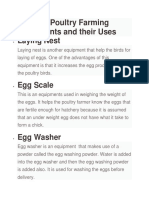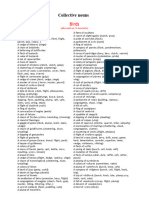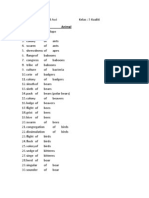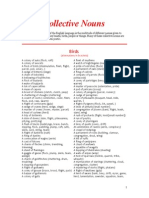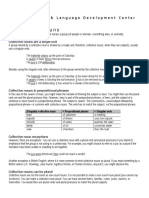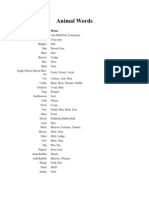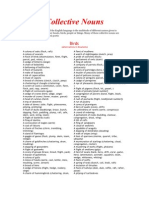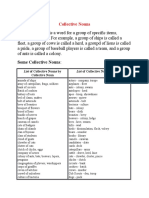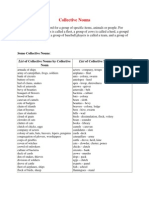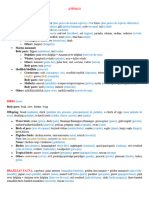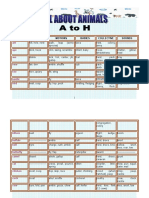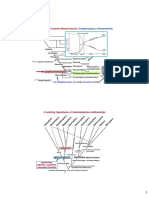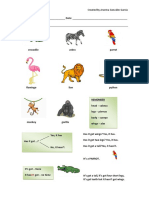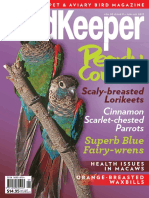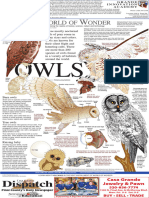0 ratings0% found this document useful (0 votes)
35 viewsCollective Nouns: Classificação
Collective Nouns: Classificação
Uploaded by
Robson EspinosaThis document lists various collective nouns used to describe groups of animals. Some examples include:
- A clowder of cats
- A colony of ants, bacteria, badgers, and other animals that live in colonies
- An army of ants, caterpillars, and frogs
- A band of birds and gorillas
- A drove of goats, hares, oxen, pigs, and sheep
- A flock of birds, camels, chickens, ducks, geese, and sheep
Copyright:
© All Rights Reserved
Available Formats
Download as PDF, TXT or read online from Scribd
Collective Nouns: Classificação
Collective Nouns: Classificação
Uploaded by
Robson Espinosa0 ratings0% found this document useful (0 votes)
35 views2 pagesThis document lists various collective nouns used to describe groups of animals. Some examples include:
- A clowder of cats
- A colony of ants, bacteria, badgers, and other animals that live in colonies
- An army of ants, caterpillars, and frogs
- A band of birds and gorillas
- A drove of goats, hares, oxen, pigs, and sheep
- A flock of birds, camels, chickens, ducks, geese, and sheep
Original Title
Collective Nouns
Copyright
© © All Rights Reserved
Available Formats
PDF, TXT or read online from Scribd
Share this document
Did you find this document useful?
Is this content inappropriate?
This document lists various collective nouns used to describe groups of animals. Some examples include:
- A clowder of cats
- A colony of ants, bacteria, badgers, and other animals that live in colonies
- An army of ants, caterpillars, and frogs
- A band of birds and gorillas
- A drove of goats, hares, oxen, pigs, and sheep
- A flock of birds, camels, chickens, ducks, geese, and sheep
Copyright:
© All Rights Reserved
Available Formats
Download as PDF, TXT or read online from Scribd
Download as pdf or txt
0 ratings0% found this document useful (0 votes)
35 views2 pagesCollective Nouns: Classificação
Collective Nouns: Classificação
Uploaded by
Robson EspinosaThis document lists various collective nouns used to describe groups of animals. Some examples include:
- A clowder of cats
- A colony of ants, bacteria, badgers, and other animals that live in colonies
- An army of ants, caterpillars, and frogs
- A band of birds and gorillas
- A drove of goats, hares, oxen, pigs, and sheep
- A flock of birds, camels, chickens, ducks, geese, and sheep
Copyright:
© All Rights Reserved
Available Formats
Download as PDF, TXT or read online from Scribd
Download as pdf or txt
You are on page 1of 2
Collective Nouns
clowder - of cats (de gatos)
CLASSIFICAÇÃO
colony - of ants (de formigas), of bacteria (de bacté-
rias), of badgers (de texugos), of beavers (de casto-
Collective Nouns
res), of gulls (de gaivotas), of penguins (de pinguins),
of rabbits (de coelhos), of rats (de ratos)
2. Animals (animais)
aerie - of hawks (de falcões)
company - of moles (de toupeiras), of parrots (de
papagaios)
ambush - of tigers (de tigres)
crash - of hippopotami (de hipopótamos), of rhino-
army - of ants (de formigas), of caterpillars (de lagar-
ceri (de rinocerontes)
tas), of frogs (de sapos)
culture - of bacteria (de bactérias)
array - of hedgehogs (de ouriços)
den - of snakes (de cobras)
bale - of turtles (de tartarugas)
descent - of woodpeckers (de pica-paus)
band - of birds (de aves), of gorillas (de gorilas)
down - of hares (de lebres), of sheep (de ovelhas)
barren - of mules (de mulas)
dray - of squirrels (de esquilos)
bed - of clams (de moluscos), of oysters (de ostras),
of snakes (de cobras)
drove - of goats (de cabras, de bodes), of hares (de le-
bres), of oxen (de bois), of pigs (de porcos), of sheep
bevy - of doves (de pombos), of otters (de lontras), of
(de ovelhas)
swans (de cisnes)
family - of otters (de lontras)
bloat - of hippopotami (de hipopótamos)
flight - of bees (de abelhas)
brood - of chicks (de pintos), of chickens (de gali-
nhas), of hens (de galinhas)
float - of crocodiles (de crocodilos)
bury - of conies (de coelhos), of rabbits (de coelhos)
flock - of birds (de pássaros), of camels (de camelos),
of chickens (de galinhas), of ducks (de patos), of gee-
cete - of badgers (de texugos)
se (de gansos), of sheep (de ovelhas)
charm - of hummingbirds (de beija-flores)
flush - of ducks (de patos)
clan - of hyenas (de hienas)
gaggle - of geese (de gansos)
cloud - of gnats (de mosquitos)
gam - of whales (de baleias)
You might also like
- A List of Poultry Farming Equipments and Their UsesDocument6 pagesA List of Poultry Farming Equipments and Their Usesroque esame0% (1)
- Sex Determination in 58 Bird Species and Evaluation of CHD Gene As A Universal Molecular Marker in Bird Sexing Vucicevicetal.2013Document9 pagesSex Determination in 58 Bird Species and Evaluation of CHD Gene As A Universal Molecular Marker in Bird Sexing Vucicevicetal.2013Anonymous i71HvPXNo ratings yet
- The Ugly Duckling - Short Stories For KidsDocument5 pagesThe Ugly Duckling - Short Stories For KidsAlo VeraNo ratings yet
- MAIS Collective Nouns: ClassificaçãoDocument2 pagesMAIS Collective Nouns: ClassificaçãoRobson EspinosaNo ratings yet
- Collective NameDocument5 pagesCollective NamelyshialyshiaNo ratings yet
- Collective Nouns of AnimalsDocument8 pagesCollective Nouns of AnimalsARININo ratings yet
- Birds (Alternatives in Brackets)Document4 pagesBirds (Alternatives in Brackets)adilah_anuar_1No ratings yet
- Ngaran SasatoanDocument6 pagesNgaran Sasatoancucu susilawatiNo ratings yet
- Collective Nouns A-Z NewDocument9 pagesCollective Nouns A-Z NewFernando Padua ArceNo ratings yet
- Collective Noun ListDocument13 pagesCollective Noun Listsanu HalderNo ratings yet
- Collective Nouns, Rare and FunnyDocument6 pagesCollective Nouns, Rare and FunnyecartetescuissesNo ratings yet
- Flash Card AnimalDocument16 pagesFlash Card AnimalGraita PurwitasariNo ratings yet
- Collective NounsDocument4 pagesCollective NounsPradeep KumarNo ratings yet
- Collective Nouns For BirdsDocument4 pagesCollective Nouns For Birdsshivamkumarbhaiya01No ratings yet
- Birds: (Alternatives in Brackets)Document6 pagesBirds: (Alternatives in Brackets)Mandy ChengNo ratings yet
- Microsoft Word - Animal KingdomDocument2 pagesMicrosoft Word - Animal KingdomAis 1234No ratings yet
- Termino ColectivoDocument11 pagesTermino ColectivoEli HernandezNo ratings yet
- Collective NameAnimalDocument6 pagesCollective NameAnimalNorshida Abu BakarNo ratings yet
- Collective NounsDocument6 pagesCollective NounsArvind VichareNo ratings yet
- Collective NounDocument7 pagesCollective Nounsaj7689No ratings yet
- Bird Order ChartDocument6 pagesBird Order ChartTheTeachersDesk.info100% (3)
- Nouns Collective Nouns Accessible June 2020Document2 pagesNouns Collective Nouns Accessible June 2020Omar HNo ratings yet
- Animal WordsDocument14 pagesAnimal WordsAffidah AfandiNo ratings yet
- Collective Nouns: Sleuth of Bears To A Murder of Crows. The Following Is A List of The Correct Terms ToDocument10 pagesCollective Nouns: Sleuth of Bears To A Murder of Crows. The Following Is A List of The Correct Terms ToVanessa BultronNo ratings yet
- Collective NounsDocument5 pagesCollective NounshaikalaliNo ratings yet
- UPSR List of Collective NounsDocument4 pagesUPSR List of Collective NounsIvy BolokNo ratings yet
- Birds: (Alternatives in Brackets)Document8 pagesBirds: (Alternatives in Brackets)Yeeling PhungNo ratings yet
- Farrah Ronald Yani: Hǔ (Tiger)Document2 pagesFarrah Ronald Yani: Hǔ (Tiger)RONALD DECK YAMINo ratings yet
- Collective NounsDocument6 pagesCollective NounsCik JawNo ratings yet
- Terms of VeneryDocument2 pagesTerms of Venerysky-knightNo ratings yet
- The Zoological GardenDocument6 pagesThe Zoological GardenOrlando CueroNo ratings yet
- (Twelve or More) : (-Suggested by Roy Waller of BBC Radio Norfolk, Roy - Waller@bbc - Co.uk-)Document6 pages(Twelve or More) : (-Suggested by Roy Waller of BBC Radio Norfolk, Roy - Waller@bbc - Co.uk-)Ayuni AhmadNo ratings yet
- 200 Examples of Collective Nouns in EnglishDocument3 pages200 Examples of Collective Nouns in EnglishVipin DixitNo ratings yet
- Irregular Plural NounsDocument2 pagesIrregular Plural NounsEszter SzegediNo ratings yet
- Collective NameDocument2 pagesCollective NameJipson LawranceNo ratings yet
- AnimalsDocument7 pagesAnimalskaynnanathosNo ratings yet
- Activity 3 BioticsDocument1 pageActivity 3 BioticsseoraksanNo ratings yet
- Animals in Spanish: 104 WordsDocument3 pagesAnimals in Spanish: 104 WordsElie YabroudiNo ratings yet
- Collective Nouns: Birds (Alternatives in Brackets)Document33 pagesCollective Nouns: Birds (Alternatives in Brackets)Xsey Doh TukarnamoNo ratings yet
- Collective Nouns: Collective Name Animal Collective Name AnimalDocument6 pagesCollective Nouns: Collective Name Animal Collective Name AnimalMiyYenNo ratings yet
- GRAMMAR - Collective NounsDocument23 pagesGRAMMAR - Collective Nounsduan4evaNo ratings yet
- Collective Nouns: (Animals)Document2 pagesCollective Nouns: (Animals)Toady SeniorNo ratings yet
- Collective NounsDocument3 pagesCollective NounsJagdeesh GosineNo ratings yet
- Owl Pellets - Prelim Research PDFDocument1 pageOwl Pellets - Prelim Research PDFGrace BohanNo ratings yet
- Groups of Animals NamesDocument5 pagesGroups of Animals NamesDEEPAK KRNo ratings yet
- The Natural WorldDocument4 pagesThe Natural WorldTran MaiNo ratings yet
- List 22 - Objects, Animals and Sounds: Comprehensive Site For English Learning (/)Document3 pagesList 22 - Objects, Animals and Sounds: Comprehensive Site For English Learning (/)Ajay Kumar PalNo ratings yet
- English Vocabulary - AnimalsDocument3 pagesEnglish Vocabulary - AnimalsChristinaSantosNo ratings yet
- 200+ Collective NounsDocument3 pages200+ Collective NounsAP's EducationNo ratings yet
- Phonetic Animals ListDocument6 pagesPhonetic Animals ListJOHN. J MESANo ratings yet
- Collective NounsDocument17 pagesCollective NounsLia IanaNo ratings yet
- AnimalsDocument5 pagesAnimalsJoão Marcelo Silva GomesNo ratings yet
- (Ánt Íter) (Ántiloup) : AnteaterDocument3 pages(Ánt Íter) (Ántiloup) : AnteaterCompuDell MazateNo ratings yet
- KET Vocabulary KET Vocabulary: The KEY English Test The KEY English TestDocument17 pagesKET Vocabulary KET Vocabulary: The KEY English Test The KEY English TestGhada ShohiebNo ratings yet
- Animal Homes Motions Babies Collective Sounds: Ant Ape Ass Bear Bee Beetle BirdDocument5 pagesAnimal Homes Motions Babies Collective Sounds: Ant Ape Ass Bear Bee Beetle BirdMaria Dolores Barrionuevo AlvarezNo ratings yet
- List of 100 Animal Home NamesDocument12 pagesList of 100 Animal Home NamesPonnammaNo ratings yet
- The Origin of Complete Metamorphosis: Endopterygota HolometabolaDocument13 pagesThe Origin of Complete Metamorphosis: Endopterygota HolometabolaCarlos Enrique Pijo PerezNo ratings yet
- Collective Nouns: Common Group NamesDocument8 pagesCollective Nouns: Common Group Namesvanessa rodriguez minaya100% (1)
- Word List Animals and Their YoungDocument2 pagesWord List Animals and Their YoungWahieda Abd WahabNo ratings yet
- Birds Around Us 53657Document2 pagesBirds Around Us 53657NicoNo ratings yet
- The Princeton Field Guide to Prehistoric MammalsFrom EverandThe Princeton Field Guide to Prehistoric MammalsRating: 5 out of 5 stars5/5 (5)
- Spanish Vocabulary Glossary, Animals, English to Spanish, Español a InglésFrom EverandSpanish Vocabulary Glossary, Animals, English to Spanish, Español a InglésNo ratings yet
- English Spanish Dictionary Thematic I: 1.000 Spanish English words with Bilingual Text in Thematic Categories, to learn Spanish vocabulary fasterFrom EverandEnglish Spanish Dictionary Thematic I: 1.000 Spanish English words with Bilingual Text in Thematic Categories, to learn Spanish vocabulary fasterNo ratings yet
- Vocabulary UNIT 5 Great Explorers 3Document2 pagesVocabulary UNIT 5 Great Explorers 3BENITO JOSE CASTELLANO SANCHEZNo ratings yet
- Australian Birdkeeper - June - July 2017Document68 pagesAustralian Birdkeeper - June - July 2017Maria MorenoNo ratings yet
- Year 7 Optional 2008 English Levels 3 4 Reading BookletDocument12 pagesYear 7 Optional 2008 English Levels 3 4 Reading BookletTimeNo ratings yet
- ANSCI43 Duck Inventory 3Document30 pagesANSCI43 Duck Inventory 3MARK LOUIE SUGANOBNo ratings yet
- Year 1 P1Document7 pagesYear 1 P1SUBASINY A/P RAJOO MoeNo ratings yet
- Cockatiel Sex Comparison ChartDocument2 pagesCockatiel Sex Comparison ChartShyam BKNo ratings yet
- Poultry-A Guide To Anatomy and Selected SpeciesDocument20 pagesPoultry-A Guide To Anatomy and Selected Speciesmsobhan100% (1)
- Human CivilizationDocument26 pagesHuman Civilizationlrk wildlifeNo ratings yet
- NOV 2009 Apalachee Audubon Society NewsletterDocument8 pagesNOV 2009 Apalachee Audubon Society NewsletterApalachee Audubon SocietyNo ratings yet
- Free Birding Workshop in Wenatchee!: Artwork by Steven D'AmatoDocument8 pagesFree Birding Workshop in Wenatchee!: Artwork by Steven D'AmatoBridget EganNo ratings yet
- Arunachal PradeshDocument12 pagesArunachal PradeshAbprez KimsingNo ratings yet
- Abigail McBride, "Don't Call It A Seagull!"Document41 pagesAbigail McBride, "Don't Call It A Seagull!"MIT Comparative Media Studies/WritingNo ratings yet
- Ayam PetelurDocument10 pagesAyam Petelurisma_fiNo ratings yet
- Deterrent Techniques and Bird Dispersal Approach FDocument89 pagesDeterrent Techniques and Bird Dispersal Approach FAlma ChávezNo ratings yet
- Birds of GujaratDocument40 pagesBirds of GujaratAshish MakNo ratings yet
- Chickens 101:: A Beginner'S Guide To Raising Backyard ChickensDocument18 pagesChickens 101:: A Beginner'S Guide To Raising Backyard ChickensIulian MihaiNo ratings yet
- Learner'S Quarterly Data in EnglishDocument3 pagesLearner'S Quarterly Data in EnglishGreg Amor OmapasNo ratings yet
- Introduction To Ostrich ScienceDocument25 pagesIntroduction To Ostrich ScienceGeofrey ChrissNo ratings yet
- Azores Nature Trip Report June 2015Document19 pagesAzores Nature Trip Report June 2015Peter AlfreyNo ratings yet
- Red Tailed HawkDocument3 pagesRed Tailed HawkNilamdeen Mohamed ZamilNo ratings yet
- Week 03 Monday Reading (Irvin García)Document3 pagesWeek 03 Monday Reading (Irvin García)karen gonzalezNo ratings yet
- Assessment of The Diversity of Wading Birds and SDocument15 pagesAssessment of The Diversity of Wading Birds and SMohamed MuayidNo ratings yet
- 5fd14bd2696d8 PDFDocument1 page5fd14bd2696d8 PDFgalinaortholightNo ratings yet
- Anthropology A Global Perspective 7th Edition all chapter instant downloadDocument24 pagesAnthropology A Global Perspective 7th Edition all chapter instant downloadfayyoodefeu100% (2)
- American Kestrel Factsheet 1 4Document2 pagesAmerican Kestrel Factsheet 1 4api-252996168No ratings yet
- Full download Emergency Orthopedics 6th Robert R. Simon MD FAAEM pdf docxDocument34 pagesFull download Emergency Orthopedics 6th Robert R. Simon MD FAAEM pdf docxbdaxmlazm53100% (2)
- Birds: Prof. AN. Subramanian and Dr. A. SethuramanDocument8 pagesBirds: Prof. AN. Subramanian and Dr. A. SethuramanMuh SaifullahNo ratings yet
